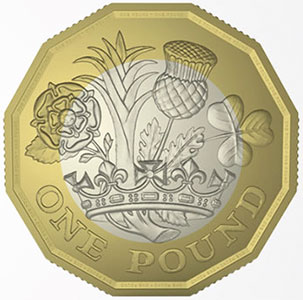 The British Chancellor of the Exchequer, Rt. Hon George Osborne today revealed the winning design for the new £1 coin. A public design competition was launched in September 2014, and after the judging of 6,000 design entries 15 year-old David Pearce’s concept design was chosen for the new coin. David’s concept design has been refined for use on the final version of the coin with the support of the renowned numismatic artist David Lawrence and lettering expert Stephen Raw.
The British Chancellor of the Exchequer, Rt. Hon George Osborne today revealed the winning design for the new £1 coin. A public design competition was launched in September 2014, and after the judging of 6,000 design entries 15 year-old David Pearce’s concept design was chosen for the new coin. David’s concept design has been refined for use on the final version of the coin with the support of the renowned numismatic artist David Lawrence and lettering expert Stephen Raw.
The final design features four emblems to represent each of the nations of the United Kingdom – the English rose, the leek for Wales, the Scottish thistle, and the shamrock for Northern Ireland – emerging from a single stem within a crown.
The new coin has 12 sides and is made from bi-colour metals. It is due to enter circulation during 2017.
The current £1 coin has been in circulation for over thirty years, which is much longer than the normal life cycle of a modern British coin.
For those with long memories, the new coin’s shape is reminiscent of the old brass three pence bit (3d) that was affectionately known as the “thruppenny bit”, which soon gave rise to cockney rhyming slang’s “truppenny bits”, meaning female breasts.
An example of a 1960s version of the three pence bit (3d), which was equal to just one eightieth of a pound sterling
Although a relatively low-value coin, its purchasing power will be a surprise to today’s generation. In my early childhood several treats from the local sweet shop could be bought for just 3d or less such as the popular “penny chew” (1d) and a basic loaf of white bread would have set you back a mere 5d.

